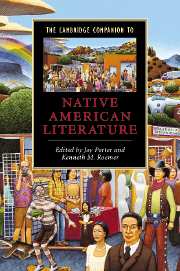Book contents
3 - Women writers and gender issues
from Part I - Historical and cultural contexts
Published online by Cambridge University Press: 28 May 2006
Summary
Although popular culture representations of the Native American woman have tended to focus upon the image of the Indian princess or the ''squaw'' - ''a violent, degraded, and filthy creature,'' Native American women writers have attempted to change these stereotypes by recording their stories in English since the nineteenth century. Native women attended reservation schools and boarding schools after the rise of reservations in 1851, but even before that some women like Jane Johnson Schoolcraft were relatively well educated. By the turn of the century, a number of Native women were highly educated and some had college degrees. As writers, they took elements of the oral storytelling tradition that had always been an integral part of their culture and incorporated them into the genres of novels, short stories, essays, and poetry. Some like Winnemucca and E. Pauline Johnson called upon Indian oration techniques to perform for the public, cultivating the Indian princess image to give them authority and to attract white audiences. Native writers extended such elements as the belief in the sacredness of language and earth, attention to place and landscape, propagation of cultural values, and concern for the community welfare as opposed to the concern for the individual into their writings. A novel by a Native American writer is not so much fiction as it is ''witnessing'' significant events through time.
- Type
- Chapter
- Information
- The Cambridge Companion to Native American Literature , pp. 85 - 102Publisher: Cambridge University PressPrint publication year: 2005
- 2
- Cited by



